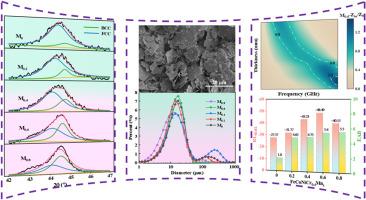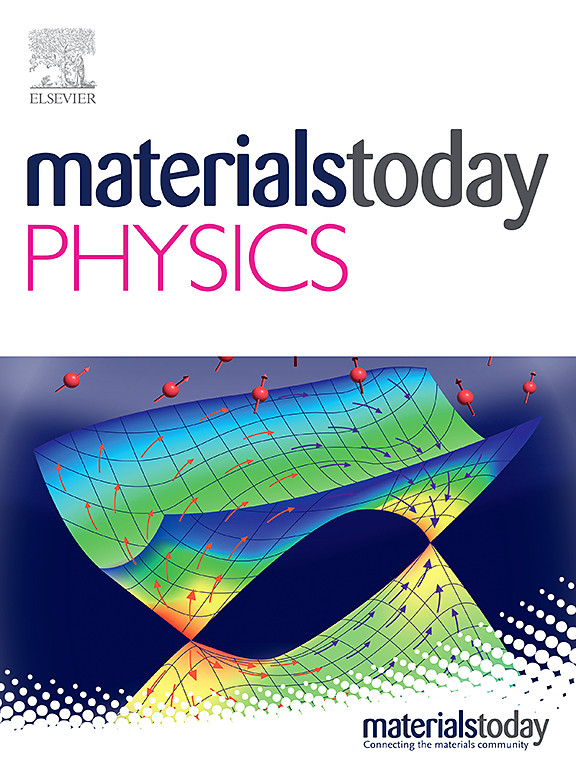Improving electromagnetic wave absorption performance by adjusting the proportion of brittle BCC phase in FeCoNiCr0.4Mnx high-entropy alloys
IF 10
2区 材料科学
Q1 MATERIALS SCIENCE, MULTIDISCIPLINARY
引用次数: 0
Abstract
High-entropy alloys, as a novel type of absorber, exhibit exceptional electromagnetic modulation capabilities and significant potential for electromagnetic wave absorption. In this work, the FeCoNiCrMn high-entropy alloy absorbent prepared through a mechanical alloying process demonstrates a dual-phase solid solution structure comprising face-centered cubic (FCC) and body-centered cubic (BCC) phases. By varying the manganese (Mn) content in the system, it is possible to enhance the degree of crystallinity, maintain the integrity of the crystal structure, and effectively control the relative proportion of the BCC phase within the overall phase composition. This adjustment improves the brittleness of the sheet-like particles, reduces particle size, and significantly lowers the permittivity. When the molar ratio of Mn is 0.6, the sample exhibits improved impedance matching due to the optimal permittivity and permeability. Notably, the impedance matching and attenuation constant can also be balanced. At 6.42 GHz, the FeCoNiCr0.4Mn0.6 alloy powder achieves the maximum reflection loss of −48.49 dB at a matching layer thickness of 3 mm. When the matching thickness is reduced to 2 mm, it can effectively cover a frequency range of 8.7–14.1 GHz (effective absorption bandwidth of 5.4 GHz), along with a wide absorption bandwidth and high absorption efficiency.

通过调整脆性 BCC 相在 FeCoNiCr0.4Mnx 高熵合金中的比例提高电磁波吸收性能
高熵合金作为一种新型吸波材料,具有优异的电磁调制能力和巨大的电磁波吸收潜力。在这项研究中,通过机械合金化工艺制备的铁钴镍铬锰高熵合金吸波材料展示了由面心立方(FCC)相和体心立方(BCC)相组成的双相固溶体结构。通过改变体系中的锰(Mn)含量,可以提高结晶度,保持晶体结构的完整性,并有效控制 BCC 相在整个相组成中的相对比例。这种调整可以改善片状颗粒的脆性,减小颗粒尺寸,并显著降低介电常数。当锰的摩尔比为 0.6 时,由于具有最佳的介电常数和磁导率,样品的阻抗匹配得到改善。值得注意的是,阻抗匹配和衰减常数也可以达到平衡。在 6.42 GHz 频率下,FeCoNiCr0.4Mn0.6 合金粉末在匹配层厚度为 3 mm 时的最大反射损耗为 -48.49 dB。当匹配层厚度减小到 2 毫米时,它能有效覆盖 8.7-14.1 千兆赫的频率范围(有效吸收带宽为 5.4 千兆赫),同时具有较宽的吸收带宽和较高的吸收效率。
本文章由计算机程序翻译,如有差异,请以英文原文为准。
求助全文
约1分钟内获得全文
求助全文
来源期刊

Materials Today Physics
Materials Science-General Materials Science
CiteScore
14.00
自引率
7.80%
发文量
284
审稿时长
15 days
期刊介绍:
Materials Today Physics is a multi-disciplinary journal focused on the physics of materials, encompassing both the physical properties and materials synthesis. Operating at the interface of physics and materials science, this journal covers one of the largest and most dynamic fields within physical science. The forefront research in materials physics is driving advancements in new materials, uncovering new physics, and fostering novel applications at an unprecedented pace.
 求助内容:
求助内容: 应助结果提醒方式:
应助结果提醒方式:


